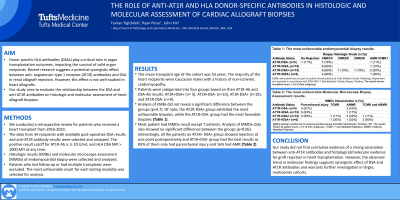Back

(P411) The Role of anti-AT1R and HLA donor-specific antibodies in histologic and molecular assessment of cardiac allograft biopsies.
Location: Platinum Ballroom

Poster Presenter(s)
Aim: Donor specific HLA antibodies (DSAs) play a critical role in organ transplantation outcomes, impacting the survival of solid organ recipients. Recent research suggests a potential synergistic effect between anti-AT1R antibodies and DSA in renal allograft rejection. However, this effect is not well-studied in heart allografts. Our study aims to evaluate the relationship between the DSA and anti-AT1R antibodies on histologic and molecular assessment of heart allograft biopsies.
Method: We conducted a retrospective review for patients who received a heart transplant from 2016-2023. The data from 34 recipients with available post-operative DSA results and anti-AT1R antibody results were selected and analyzed. The positive result cutoff for AT1R-Ab is ≥ 10 U/mL and HLA DSA MFI ≥ 1000 at any time. Histologic results and molecular microscope assessment (MMDx) of endomyocardial biopsy were collected and analyzed. Patients who lost follow-up or had multiple transplants were excluded. The most unfavorable result for each testing modality was selected for analysis.
Results: The mean transplant age of the cohort was 53 years. The majority of the heart recipients were Caucasian males with a history of non-ischemic cardiomyopathy. Patients were categorized into four groups based on their AT1R-Ab and DSA-Ab results: AT1R+DSA+ (n= 5), AT1R+DSA- (n=10), AT1R-DSA+ (n=10), and AT1R-DSA- (n=9). Analysis of EMBs did not reveal a significant difference between the groups (p=0.7). Of note, the AT1R-DSA+ group exhibited the most unfavorable biopsies, while the AT1R-DSA- group had the most favorable biopsies (Table 1). Most patient had MMDx result except 7 patients. Analysis of MMDx data also showed no significant difference between the groups (p=0.06). Interestingly, all the patients on AT1R+DSA+ group showed rejection at one point postoperatively and AT1R+DSA- group had the best results as 83% of them only had parenchymal injury and 16% had AMR (Table 2).
Conclusion: Our study did not find conclusive evidence of a strong association between anti-AT1R antibodies and histological/molecular evidence for graft rejection in heart transplantation. However, the observed trend in molecular findings supports synergistic effect of DSA and AT1R antibodies and warrants further investigation in larger, multicenter cohorts.
Method: We conducted a retrospective review for patients who received a heart transplant from 2016-2023. The data from 34 recipients with available post-operative DSA results and anti-AT1R antibody results were selected and analyzed. The positive result cutoff for AT1R-Ab is ≥ 10 U/mL and HLA DSA MFI ≥ 1000 at any time. Histologic results and molecular microscope assessment (MMDx) of endomyocardial biopsy were collected and analyzed. Patients who lost follow-up or had multiple transplants were excluded. The most unfavorable result for each testing modality was selected for analysis.
Results: The mean transplant age of the cohort was 53 years. The majority of the heart recipients were Caucasian males with a history of non-ischemic cardiomyopathy. Patients were categorized into four groups based on their AT1R-Ab and DSA-Ab results: AT1R+DSA+ (n= 5), AT1R+DSA- (n=10), AT1R-DSA+ (n=10), and AT1R-DSA- (n=9). Analysis of EMBs did not reveal a significant difference between the groups (p=0.7). Of note, the AT1R-DSA+ group exhibited the most unfavorable biopsies, while the AT1R-DSA- group had the most favorable biopsies (Table 1). Most patient had MMDx result except 7 patients. Analysis of MMDx data also showed no significant difference between the groups (p=0.06). Interestingly, all the patients on AT1R+DSA+ group showed rejection at one point postoperatively and AT1R+DSA- group had the best results as 83% of them only had parenchymal injury and 16% had AMR (Table 2).
Conclusion: Our study did not find conclusive evidence of a strong association between anti-AT1R antibodies and histological/molecular evidence for graft rejection in heart transplantation. However, the observed trend in molecular findings supports synergistic effect of DSA and AT1R antibodies and warrants further investigation in larger, multicenter cohorts.

